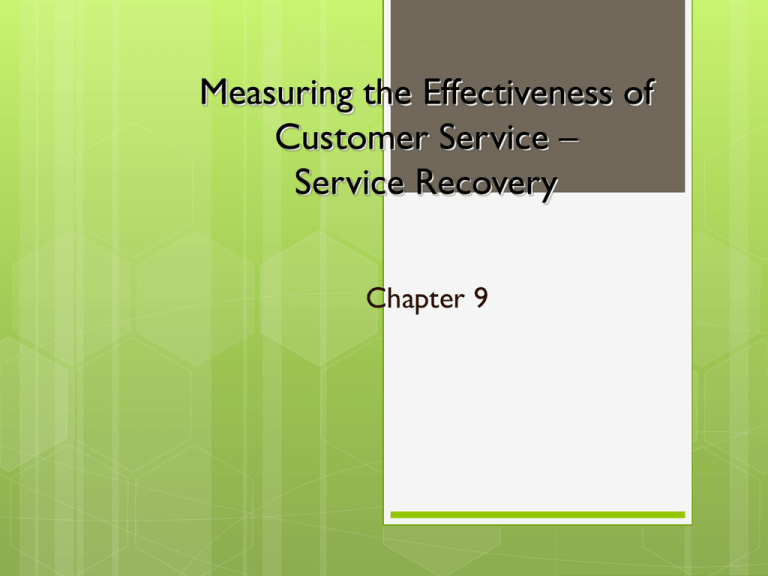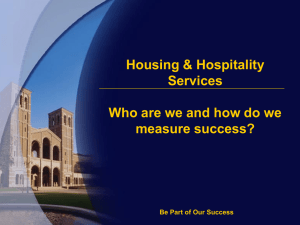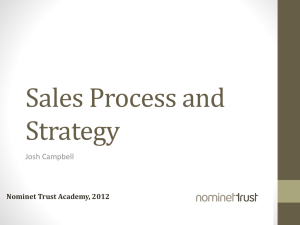Measure the Effectiveness of the Service Process – Service Recovery
advertisement

Measuring the Effectiveness of Customer Service – Service Recovery Chapter 9 Cost of Failure Average company will lose half its customers every five years It can cost five times more to buy new customers than retain existing ones. The average customer with a poor experience will tell 11 people. They will talk about it for twenty three years 13% of customers with an unresolved complaint will tell more than 20 people. As many as 90% of complainers will return to your business if their complaint is resolved. For every complaint received, the average company has 26 unhappy customers who never complain. Source: TARP Data - Technical Assistance Research Programs Benefits of Recovery Reducing customer defections (when a customer does not return) can boost profits by 25-85%. In 73% of cases, the organization made no attempt to persuade dissatisfied customers to stay; even though 35% said that a simple apology would have prevented them from moving to the competition. Source: NOP London based market research organization Cost of Failure - Relationships and Loyalty Keep in mind that the seriousness of the matter is important. The more serious the failure, the more likely the customer is to switch to another company, no matter what recovery effort the company makes. A strong employee-customer relationship can have a mediating effect on satisfaction and thus on the intention to stay or defect. The perception of the customer is the reality! Customer retention requires managers and staff to have: Positive attitude toward problem solving Seeing complaints as opportunities to create stronger loyalty But not necessarily a “customer is always right” mentality because…..(see next slide) The Key issue in customer disputes is… NOT How who is right or wrong, but rather all parties can cooperate to solve the customer’s concerns Key skills in recovery Feel the customer’s pain (empathize) Do all that is possible to resolve the problem Offer “symbolic atonement”-something extra to appease the customer. Examples at the bottom of pg 135. ATTITUDE is critical Abrasiveness is counterproductive Assertiveness is better for problem resolution “assertive” means being pleasantly direct Getting It Right The First Time: Reducing The Frequency And Impact Of Failures Leadership in maintaining strong customer focus Feedback/complaint management Continuous improvement Benchmarks-for example, if customers have been complaining about long wait times to be seated set a goal related to that. Would your business want 80% of the customers to be happy with their seating? 90%? More? Would there be a different kind of benchmark that could be set? Service guarantees-could they be guaranteed seating within 10 minutes or they get a free meal? What are other ideas? Failures Do Happen… No matter how rigorous the procedures and employee training are, or how advanced the technology, zero defects is an unattainable goal. Plan for your failures and learn from them. Planning and learning are the cornerstones of Service Recovery… 99.9% is Good Enough So what is Service Recovery? It is the actions the company takes in response to service failure. It should be a management philosophy that holds customer satisfaction as a primary concern. And not only to satisfy our customers, but to WOW them. The Service Recovery Paradox A service recovery that exceeds expectations results in higher customer satisfaction than the satisfaction level of customers who never report a failure. To Build an Effective and Proactive Recovery System: Measure costs of effective service recovery Break customer silence Anticipate needs for recovery Act fast Train employees Empower the front line Close the customer feedback loop Figure 7.3 Empowerment–Service Recovery Relationship Key ingredients to effective service recovery: Acknowledge the problem or failure Explain the reason(s) for the failure when possible Empathize, with a sincere expression of feeling for the customer’s inconvenience Apologize if needed by using the customer’s name and being specific about what he/she is complaining about Solve the problem as quickly as possible-speed is crucial Compensate the customer appropriately Thank the customer Provide extra value Follow-up How to Handle Irate Customers Sample customer service video Ways to Strengthen Service OrientationInternal Customer Employees should never complain within earshot of customers to customers about other employees Employees should strive to build bridges between departments. Let employees become “customers” for a day. Meet afterwards and learn what they discovered so that everyone can learn from the experience. Metrics We have to measure first to see how we’re doing and then improve upon that. We use “metrics” and “benchmarking” for this. What Are Metrics? Metrics are a collection of tools used for benchmarking (or setting the standard) for: Organizational performance Divisional performance Personal performance over a period of time What are some examples of metrics? If you need data, it can be obtained from internal or external sources (customers or employees) primary or secondary sources (inside or outside your business) Using qualitative or quantitative measures Or combining different types of data











